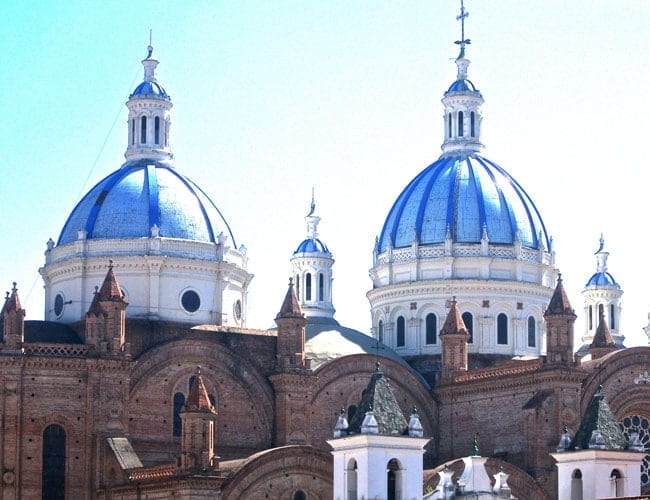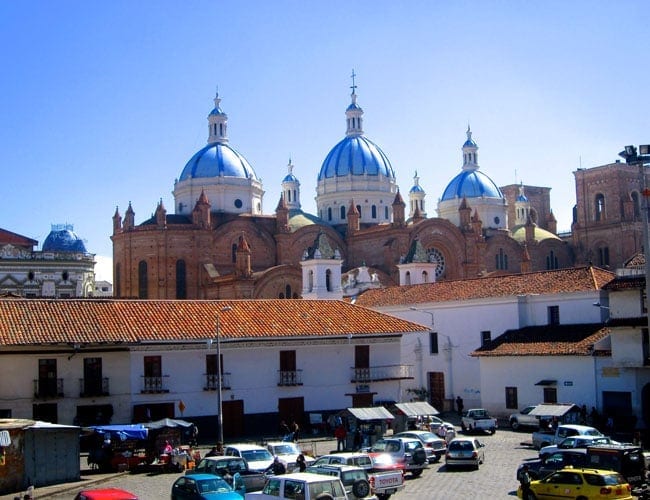History
Cuenca is the third largest City in Ecuador, and the second to be named a UNESCO World Heritage Site. The other WHS site is the capitol city, Quito. There is much rivalry as to which is more beautiful.
I will not take sides, except to say that Cuenca is known as the “Athens of Ecuador.” And this is because of the exceptional Classical Architecture within the boundaries of the Central Historic area.
Founded in 1557, Cuenca was constructed according to the orthogonal plan decreed by Charles V of Spain, who ruled at that time. The Orthogonal design calls for right or perpendicular angles in the original Greek plans. Town Planners today would call this a “Grid Pattern.” Today, Cuenca is a charming, well-preserved colonial City with most of the buildings date from the 18th and 19th centuries.
The historic area over two hundred and fifty square blocks of original buildings, cathedrals, churches, plazas and parks, connected by cobblestone streets. Being compact, it is easily walkable.
Colonial Cuenca today functions as a modern city within the Colonial framework with modern amenities. The shops, internet cafes, restaurants, hotels, taxis, buses and all the usual tools needed to create a busy economy are there in abundance.
The Geography of Cuenca
Located 8,200 feet above sea level, the temperature ranges between 50 and the low 70 degrees Fahrenheit and is always on the cool side.
The high altitude can be physically challenging. Cuenca lies in a fertile valley surrounded by four rivers and is set against a backdrop of Andean peaks. The Rio Tomebamba is the most important river and cradles the city. It runs clear and strong through the rocky basin, separating the historic center on its higher north side from modern Cuenca on the lower south side.
The later part of Cuenca developed when the Historic Center grew too small to handle the population and its needs. By contrast, the new part offers modern office buildings, apartments, hospitals and more diversified shopping including supermarkets and shopping centers.
Demographics
The population is under a half million people. There are eight universities, the oldest is the University of Cuenca, founded in 1867. It has long been a center for culture and learning. The large number of students who attend lend a youthful edge to the population and creates a Bohemian atmosphere.
Tourism and Accommodations
With so much beauty and history, Cuenca is a magnet for tourists. There is a diverse selection of accommodations. Some Colonial-era smaller homes are converted to Posadas and rent out as bed and breakfast inns. Some mansions are now renovated into luxury boutique hotels.
There are strict rules in maintaining the Colonial character and there are no Ritz Carlton or Hilton Hotels and no fast food franchises as these would take away from the authenticity of Cuenca. Thus, the hotels in the Historic Center are housed in historic buildings.
The Hotel Victoria, one of the better-known mansion conversions, is built into the Barranca cliff. It appears to “hang” from the clifftop. Located on the Calle Larga, a very beautiful street on the edge of the historic center, it provides amazing views of the extensive hotel gardens and the river.
The restaurant, El Jardin, located on one of the lower levels also has views “forever.” It serves a sophisticated menu of international food and fine wine with beautifully appointed table settings. This hotel is very gracious and has some lovely old antique furnishings.
Not so nice
My carefully chosen hotel reservation turned into a “rough landing.” There was a huge discrepancy between the hotel description on the internet, and what it actually looked like. The only redeeming feature was the spectacular view from the bedroom window.
Prying open the wooden shutters in our room, the scene below was of busy, cobblestone market square, with the craft market at the far end. Clearly visible were the three iconic blue-tiled domes of the Nuevo Cathedral, rising above the roofline. Set against a cloudless blue sky – it is probably the most photographed and easily recognizable view of Cuenca.
After surviving one night of drafty pneumonia-like temperatures and a drip, drip shower, the view was not enough to keep me there. In less than eighteen hours, I moved to the Posada del Angel, a total contrast.
Very Nice
Posada del Angel was gleaming, all polished wood, with spotless marble floors. Beautiful green potted plants flourished in the light from the huge glass dome set into the roof three floors up.
The design was a traditional Colonial residence conversion, with a large open area in the center for the restaurant, and lounges surrounded by floors of bedrooms above. It was overseen with great love by an Ecuadorian family who also ran the Italian restaurant in the hotel. The family was charming and helpful. After settling in, my mood lifted, and I was on my way to enjoying Cuenca.
Americans in Cuenca
Cuenca is popular with both travelers and ex-Pats and there is no shortage of English being spoken. The Cuencanos (local residents of Cuenca) have welcomed the growing ex-pat population composed mainly of American retirees. They moved to Cuenca, some part-time but mostly full time. The official count is 5,000 persons, but it could be twice that number and growing.
Many Americans have taken out residency in Ecuador and more are in the process of applying for their Ecuadorian passports, which come with generous retiree benefits. Not only have they been welcomed, but they have found an interesting City, with lots of cultural activities, live theater, many museums and galleries and a symphony orchestra. They have identified causes in which they can volunteer and have done so generously.
There are different reasons why people have decided to move to a new country so late in life. Primary is they can live a better-quality life on less money with fewer worries. The cost of Medical Insurance is far lower and medical services are a fraction of the cost paid in the USA. Medical facilities and hospitals are modern, and the doctors are excellent, many having spent extra time studying abroad, in Europe, the USA and Mexico.
Healthier lifestyle
The new American residents are leading healthier lives, eating more fresh fruit and vegetables, priced inexpensively in the markets. This diet, combined with the fact that people walk more than they did in the US, has led to improved health and less dependence on medications to stay well.
The one complaint the local population has with these new residents is that they do not make enough effort to learn Spanish and expect their hosts to speak English!!
Originally published in October, 2013, this article is revised and re-published here.






